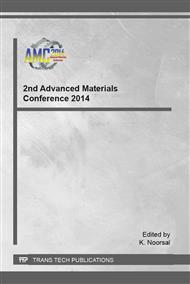p.612
p.619
p.624
p.629
p.634
p.639
p.644
p.649
p.654
Advances in Evaluation of Surfactant Performances at High Temperature by Static Foam Tests
Abstract:
—Foam stability and mobility reduction are the key parameters for foam assisted enhanced oil recovery. The harsh conditions such as high temperature, pressure and salinity present in an oil reservoir tend to destabilise the foam leading to poor sweep efficiency. Screening for the best performing foaming recipes has been performed to ascertain foam stability in the presence and absence of oil. Static foam test has been performed in order to study the foam stability and foam oil interactions at 90°C. Two anionic surfactants, alpha olefin sulphonate (AOS14-16) and methyl ester sulphonate (MES16-18) were mixed with betaine (foam booster) in different proportions to design the formulations. In addition to the ternary formulations, binary formulation involving surfactant and betaine were also evaluated for foam stability. For the study of oil effects on foaming performance of surfactant formulation, n-decane, diesel and Dulang crude oil are used. The recipes were evaluated by static foam tests to note the foam height and endurance time. It was found that the anionic surfactant played a major role in foam stability and the betaine was found less significant. However, the betaine alone was found effective for foaming and was poor for endurance time. While in mixture, the surfactant and betaine were found to interact strongly and a profound synergistic effect was noted. During oil interaction studies, the alkane type oils of low molecular weight become solubilised with surfactant molecule forming an emulsion and hence decimate the foam stability. However, higher alkanes with molecular chain more than ten carbon atoms (decane) stabilised the foam because of low solubilisation efficiency between surfactant and oil to form emulsions. The obtained results of the designed experiment have been analysed and discussed in detail to understand the contribution of individual component as well as their interactions with each other in order to stabilize foams.Keywords—Static Foam, Foam-Oil interactions, AOS, MES, Enhanced Oil Recovery
Info:
Periodical:
Pages:
634-638
Citation:
Online since:
January 2016
Authors:
Keywords:
Price:
Сopyright:
© 2016 Trans Tech Publications Ltd. All Rights Reserved
Share:
Citation:


